Enamel vs. Acrylic – The Difference Between Acrylic and Enamel Paint
There are many different kinds of paint available for purchase. In this article we will be discussing and comparing two kinds of paint commonly used by crafters, artists and hobbyists; this article is about acrylic vs. enamel paint. These two paints have a few important distinctions, as well as their own sets of pros and cons that we will be going into more detail about below. This article goes into all the intricacies of enamel vs. acrylic paint.
What Is Enamel Paint and How Is It Used?
Enamel paint is most commonly used as hardware paint for many DIY projects. Enamel paints are known for their durability, opacity, and hardness once they have dried. For a long time, enamel paints were known as being oil-based but there are now many water-based enamel paints available on the market. Both water-based and oil-based enamel paints are available in different finishes and can even be found in UV resistant and heat resistant varieties.
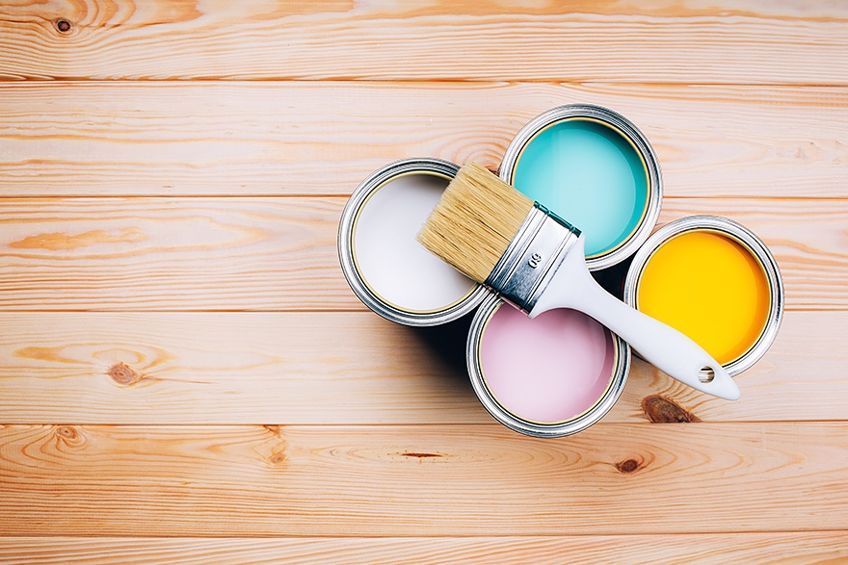
Metal surfaces, plastic, glass, wood, and bricks are all suitable surfaces that enamel paint can be applied to. Enamel paint can be applied using brushes, rollers, or even spray equipment. As with most paint, it is better to apply enamel paint in multiple thin layers than in a single, thick layer. A primer may not always be necessary while working with enamel paints but it is recommended for an optimal outcome. You should always, however, properly prepare your painting surface in other ways. This can be done by making sure that the surface is clean and by lightly sanding it down in order to help the paint adhere more readily.
Drying time varies between water-based and oil-based enamel paint.
Oil-based enamel paint should fully dry in about a day while water-based enamel paints usually take a few hours to dry. Both types of enamel can take up to a month to cure completely. The curing and drying process of enamel is also easily prolonged by environmental factors such as humidity. The benefit to using oil-based enamel is that it dries from the inside outwards. This means that once it is dry to the touch, you can be sure that it has both properly dried. Meanwhile, water-based enamel dries from the outside inwards, this means that the paint may appear dry but is still wet beneath that layer.

Oil-based enamel paints are notorious for the strong odor that they emit when used. These fumes are toxic and will have harmful effects on your health. You must be sure to take the proper precautions if you will be exposed to these fumes for a prolonged period. Proper safety gear may be necessary but at the very least you must work in a well-ventilated area. Oil-based enamel paint is also cleaned using harsh chemicals such as paint thinners or mineral spirits, which must be used and stored correctly in order to keep yourself and pets, and/or children safe. Water-based enamel paints, on the other hand, are free of toxic odors and can be cleaned with water.
Be sure to always read and closely follow the product manufacturer’s specific safety instructions.
Overall, enamel paint is best used on surfaces that are used often or are exposed to high amounts of moisture and humidity. This is because enamel paints are very water-resistant and can endure being washed down or used without having their surface ruined. This type of paint is generally used in high-traffic areas such as kitchens and bathrooms as well as in outdoor settings. They also work exceptionally well on non-porous materials such as metals, plastics, and resins because of their impressive adhesive qualities. This means that enamel paint can also be used for other purposes that you may not expect. An example of this is enamel model paint which is used by artists to paint figurines and miniatures.
Oil-Based Enamel Pros and Cons
[su_shadow style=”simple”][su_panel]- Durable and opaque
- Good for outdoor or high-traffic areas
- Available in different finishes
- Heat and UV-resistant options are available
- Can be applied to vinyl, wood, metal, glass, ceramic, and brick
- Can be applied using brushes, spray equipment, or rollers
- Dries from the inside outwards
- Can be applied without using a primer
- Long drying and curing time
- It will need to be mixed well before it can be used
- Limited range of colors
- Gives off harsh, toxic fumes
- Needs to be cleaned using harsh chemicals
- Thinned using harsh chemicals
Water-Based Enamel Pros and Cons
[su_shadow style=”simple”][su_panel]- Durable
- Faster drying time
- Good for outdoor or high-traffic areas
- Available in different finishes
- Heat and UV resistant options are available
- Can be applied to vinyl, wood, metal, glass, ceramic, and brick
- Dries from the inside outwards
- Can be applied without using a primer
- Doesn’t give off toxic fumes
- Can be cleaned with water and/or mild detergents
- Long curing time
- Less opaque than oil-based enamel
- Limited range of colors
What Is Acrylic Paint and How Is It Used?
Acrylic paint is probably the most well-known paint available on the market for artists. Acrylic is loved for its versatility, availability, and affordability. These paints are most commonly used by artists and are solely water-based, unlike enamel paints which have water-based and oil-based options. Acrylic paints usually dry to a somewhat glossy finish by nature, due to the use of polymer emulsion as the primary binder in the paint. You can however add mediums to the paint in order to change its finish to something less glossy and more textured or matte.

Acrylic paints are generally non-toxic and don’t emit any harmful fumes. You should, however, always try to work in a well-ventilated room anyway. There can still be odors present which may be overpowering for sensitive individuals, children, or pets. Acrylic paints can dry in ten minutes to an hour depending on the thickness of the application and the environment you are working in. Acrylic paint should fully cure within about a day while under optimal conditions. It is also very easy to clean up acrylic paint because it is water-soluble and can be rinsed off with water.
Acrylic paint can come in many different consistencies which allows for it to be used in various applications and be applied in different ways.
For example, you can apply heavy-bodied acrylics using a palette knife, or fluid acrylics using an airbrush. The most common way to apply acrylics however is by using an average consistency and some paintbrushes. As with most paint, it is better to apply acrylic paint in multiple thin layers than in a single thick layer. Acrylic paint can be easily applied to just about any porous surface with ease.
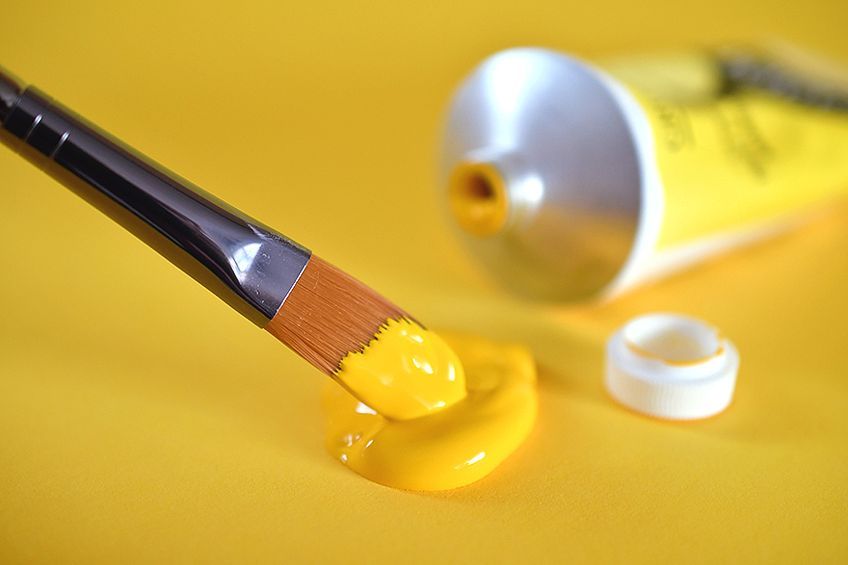
Canvas, paper, cardboard, brick, wood, and many other surfaces can easily accept acrylic paint. Other surfaces such as metal, plastic, or leather can also accept acrylic paint but may need to be primed or lightly sanded beforehand. Using a primer and a sealant isn’t always necessary when working with acrylics but it is recommended when working on smooth surfaces such as those listed above. Some artists even use acrylic modeling paint to paint their figurines, miniatures, and models. Miniatures may also need to be properly primed before having acrylic model paint applied in order to prevent any peeling as time passes.
[su_shadow style=”simple”][su_panel]- Available in different consistencies
- Can be easily applied to porous surfaces
- Can be thinned easily, using water or alcohol
- Can be applied using palette brushes, spray equipment, or rollers
- Fast drying and curing time
- Lots of colors available
- Can be easily cleaned using water and mild detergents
- Doesn’t require a primer
- Non-toxic
- Fume free and odorless
- Affordable
- Mainly available in a gloss finish
- Prone to leaving brushstrokes
- Can be prone to peeling
- Dries from the outside inwards
- Less opaque than enamel paints
- Smooth surfaces may require sanding or primer to help paint adhere
Acrylic vs. Enamel Paint
There are many different kinds of paint and they are all suited for different purposes and surfaces. In this way, you shouldn’t think of it as a battle between enamel vs. acrylic paint. You should rather think of what characteristics benefit you more due to the project at hand or your preferences and strengths as an artist. This means that you should weigh the advantages and disadvantages of using either paint for your projects before making your decision. Below we are going to highlight the difference between acrylic and enamel paint so that you can easily decide which is best for your projects.
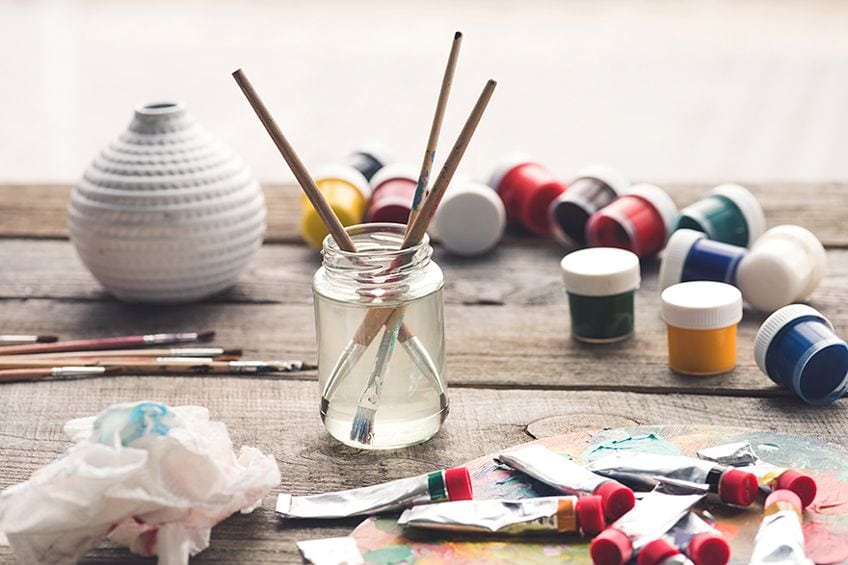
What Is the Difference Between Acrylic and Enamel Paint?
We have explained what enamel paint and acrylic paint are but the difference between acrylic and enamel paint might still be a bit vague when not compared side-by-side. The main difference when talking about enamel vs. acrylic paint is that while enamel paint is mostly oil-based, acrylic paints are water-based. A consequence of this is that water-based enamel paint and acrylic paint do not dry to be as hard and durable as oil-based enamel paint.
Both water-based and oil-based enamel paint can be applied without the use of a primer, while acrylic paint may need a primer when used on smooth surfaces such as glass, plastic, or metal.
Oil-based enamel takes around a day to dry while water-based enamel and acrylic will dry within a few hours in ideal conditions. Acrylic paint then takes another 24 hours or so to properly cure while enamels can take anywhere from a few days to a whole month. The oil in oil-based enamel paint tends to separate from the binder and pigment when stored for a while. This means that oil-based enamel paint has to be shaken well before use.
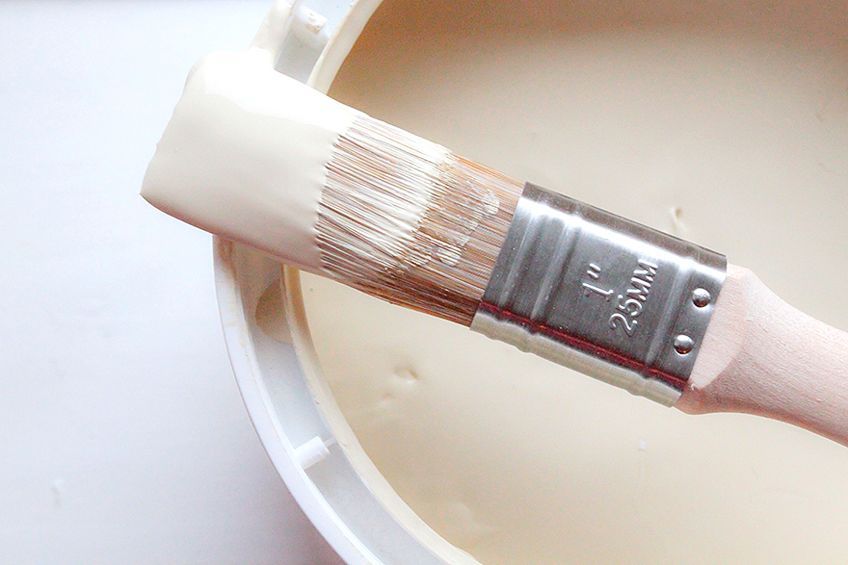
Oil-based enamel gives off fumes and requires harsh chemicals for cleaning too. Water-based enamel and acrylic paint do not have either of these issues. When kept in areas with less sunlight, oil-based enamel has a tendency to turn yellow over time. Acrylic paint doesn’t give as much coverage as enamel paints do and water-based enamel gives less coverage than oil-based enamel does. Acrylic paint and water-based enamel paint also tend to leave brushstrokes while oil-based enamel does not.
| Oil-Based Enamel Paint | Water-Based Enamel Paint | Acrylic Paint | |
| Suitable for beginners | ✘ Can be tricky to work with | ✔ Easier to work with than oil-based enamel | ✔ Very easy to work with |
| Drying time | Around a day in optimal conditions | A couple of hours in optimal conditions | An hour in optimal conditions |
| Curing time | A month in optimal conditions | A month in optimal conditions | A week in optimal conditions |
| Color variety | A decent range of colors is available | A decent range of colors is available | A wide range of colors is available |
| Finish | Usually glossy but many finishes are available | Usually glossy but many finishes are available | Glossy but mediums can be added to change the finish |
| Consistency | Thick but fluid | Thick but fluid | Different consistencies available |
| Toxicity | ✔ | ✘ | ✘ |
| Can be thinned with water | ✘ | ✔ | ✔ |
| Shows brushstrokes | ✘ | ✘ | ✔ |
| Needs primer | ✘ | ✘ | ✔ |
| Surfaces available to be painted on | Any prepared surface | Any prepared surface | All prepared porous surfaces. Non-porous surfaces need to be primed |
| Needs to be shaken before use | ✔ | ✘ | ✘ |
| Coverage | Good coverage | Good coverage | Decent coverage. May be prone to peeling over time |
| Durability | Very durable. May yellow if not exposed to sunlight | Quite durable | Fairly durable but will need a protective coating to ensure longevity |
| Price | Can be pricey | Can be pricey | Affordable |
| Cleaning method | Needs to be cleaned using thinners | Can be cleaned using water and/or mild detergents | Can be cleaned using water and/or mild detergents |
At the end of the day, it is your decision whether you want to use enamel or acrylic paint. Once you know the nature of your project it becomes easier to choose what type of paint you think will suit it best. However, this doesn’t mean that you shouldn’t experiment with both types of paint at some point. Experimenting with different paints is a great way to find what you are most comfortable with and to expand your skill set.
Frequently Asked Questions
Can Acrylic Paint and Enamel Paint be Combined?
We do not recommend mixing oil-based enamel paint with acrylic paint, as they consist of different bases. This means that they have different properties that could clash when mixed. You could, however, try to mix water-based enamel with acrylic if you wish to do so but the results may be varied and unpredictable. Alternatively, you could even try applying alternating layers of acrylic paint with layers of enamel paint.
What Is Enamel Paint Used For?
Enamel is most commonly used in outdoor or high-traffic areas. It is very well-suited for these environments because it is UV, temperature, and water-resistant.
Can You Use Enamel Paint on Canvas?
Enamel paint shouldn’t be used on canvases as the chemicals can damage the canvas itself and affect the longevity of your piece. Enamel also dries to be very hard and inflexible, which can be a problem on flexible surfaces such as canvas. Enamel on canvas is likely to crack and peel over time.
Is Enamel or Acrylic Paint Cheaper?
Acrylic paint is usually cheaper than enamel paint. However, depending on the surface you are painting with acrylic, you may need to also purchase a primer and a sealant. This means that the price could quickly add up when using acrylic paints on certain surfaces and enamel may work out to be the more cost-effective option.
Is Acrylic Model Paint or Enamel Model Paint Better?
Some artists prefer to use enamel model paint because it can maintain its vibrant and durable finish for many years. Meanwhile, other artists prefer to use acrylic model paint because it is much easier to work with and has no adverse health effects. Acrylic modeling paint is also much easier to thin and create washes with, although it is not as durable as enamel model paint. At the end of the day, it will come to each artists’ preferences and techniques.
In 2005, Charlene completed her Wellness Diplomas in Therapeutic Aromatherapy and Reflexology from the International School of Reflexology and Meridian Therapy. She worked for a company offering corporate wellness programs for a couple of years, before opening up her own therapy practice. It was in 2015 that a friend, who was a digital marketer, asked her to join her company as a content creator, and this is where she found her excitement for writing.
Since joining the content writing world, she has gained a lot of experience over the years writing on a diverse selection of topics, from beauty, health, wellness, travel, and more. Due to various circumstances, she had to close her therapy practice and is now a full-time freelance writer. Being a creative person, she could not pass up the opportunity to contribute to the Art in Context team, where is was in her element, writing about a variety of art and craft topics. Contributing articles for over three years now, her knowledge in this area has grown, and she has gotten to explore her creativity and improve her research and writing skills.
Charlene Lewis has been working for artincontext.org since the relaunch in 2020. She is an experienced writer and mainly focuses on the topics of color theory, painting and drawing.
Learn more about Charlene Lewis and the Art in Context Team.




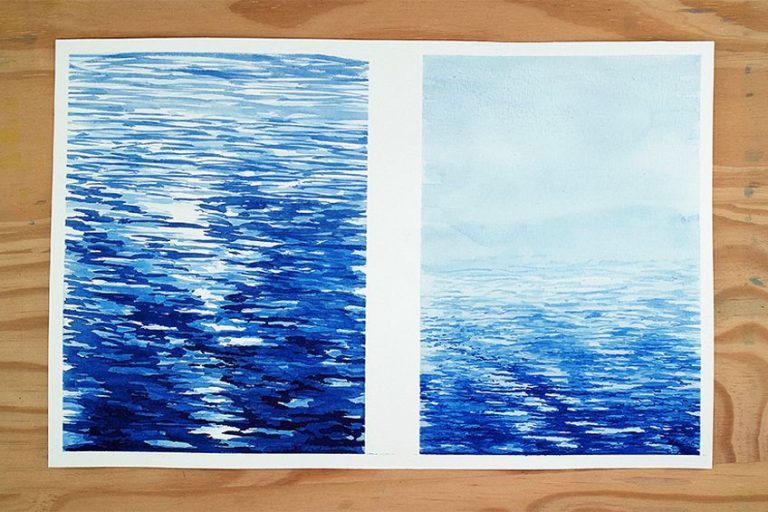
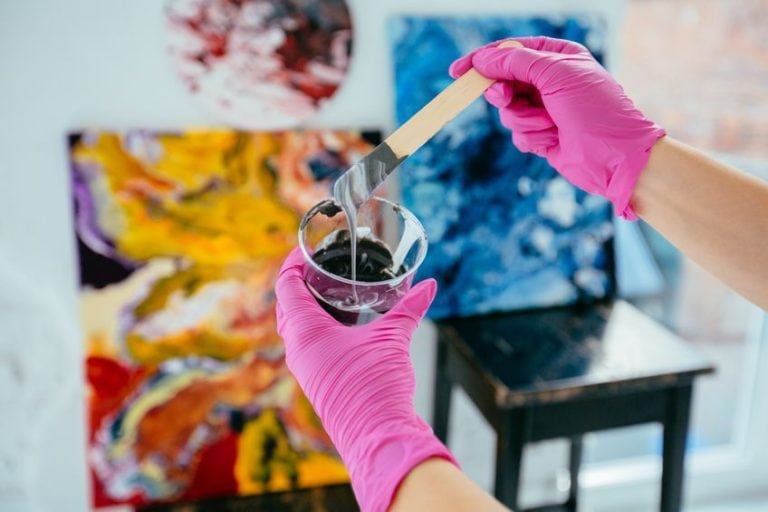


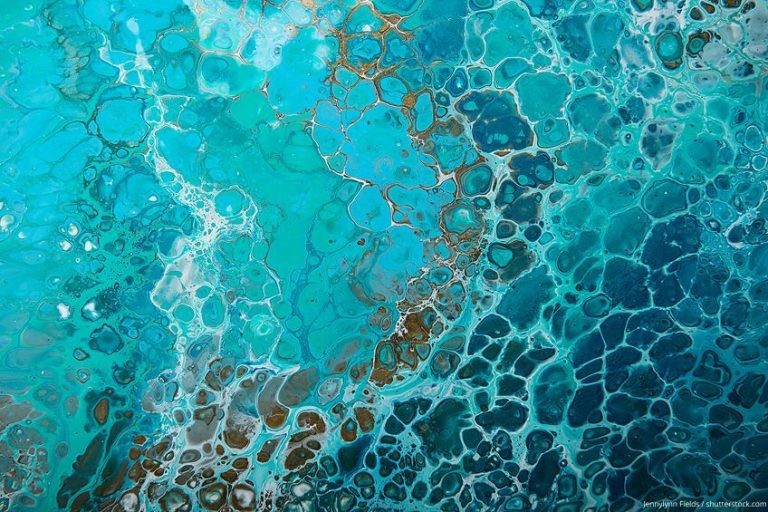

Very helpful article about enamel vs. arylics, thank you!